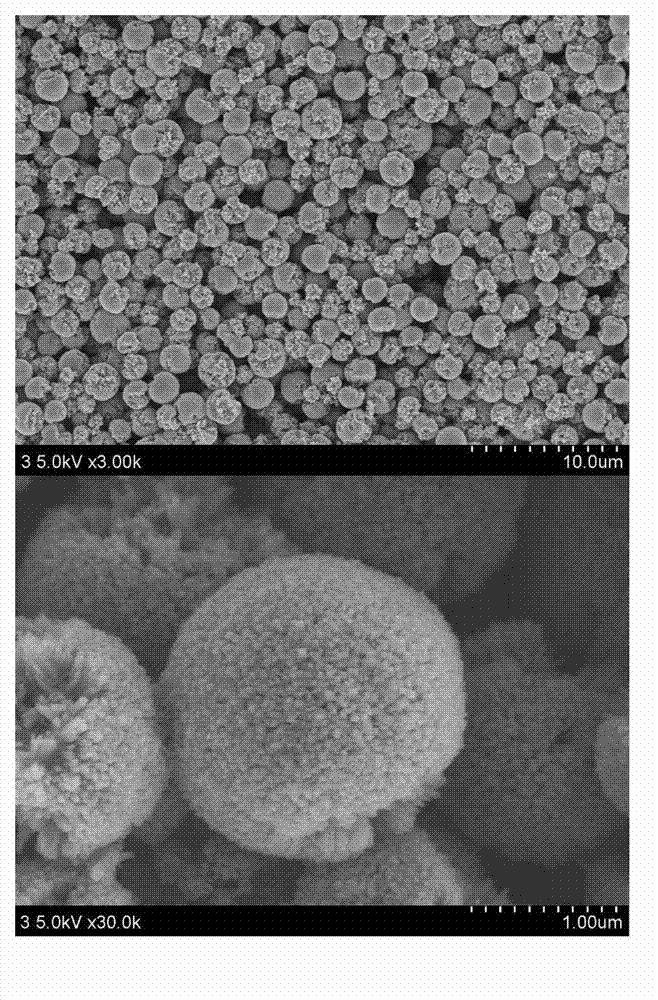Method for preparing rutile type titanium dioxide nanorod microsphere
A titanium dioxide and rutile-type technology, applied in the direction of titanium dioxide, titanium oxide/hydroxide, nanotechnology, etc., can solve the problems of unfavorable large-scale production, rare titanium oxide microspheres, wide titanium oxide microspheres, etc., and achieve particle size distribution The effect of narrow range, short cycle time and high crystallinity
- Summary
- Abstract
- Description
- Claims
- Application Information
AI Technical Summary
Problems solved by technology
Method used
Image
Examples
Embodiment 1
[0026] (1) Mix 2ml of concentrated hydrochloric acid, 1ml of deionized water and 20ml of n-hexane, then add 4ml of n-butyl titanate drop by drop under the condition of magnetic stirring, and continue to stir for 60 minutes to make n-butyl titanate The ester is completely hydrolyzed to form a layered mixed solution;
[0027] (2) Transfer the mixed solution to an autoclave with a volume of 70 ml for solvothermal reaction, control the reaction temperature to 180°C, and hold the temperature for 6 hours. After the reaction is completed, place the autoclave at room temperature to cool naturally. The precipitate was poured out, washed successively with deionized water and ethanol, and centrifuged three times to obtain rutile titanium dioxide nanorod microspheres.
[0028] The field emission scanning electron microscope image of the prepared rutile titanium dioxide nanorod microspheres ( figure 1 ), it can be seen that the diameter of the obtained microspheres is 3-5 microns, and th...
Embodiment 2
[0030] (1) Mix 2 ml of concentrated hydrochloric acid, 2 ml of deionized water and 20 ml of n-hexane, then add 4 ml of n-butyl titanate drop by drop under the condition of magnetic stirring, and continue to stir for 40 minutes to make the n-butyl titanate The butyl ester is completely hydrolyzed to form a layered mixed solution;
[0031] (2) Transfer the mixed solution to an autoclave with a volume of 70 ml for solvothermal reaction, control the reaction temperature to 180°C, and hold the temperature for 6 hours. After the reaction is completed, place the autoclave at room temperature to cool naturally. The precipitate was poured out, washed successively with deionized water and ethanol, and centrifuged three times to obtain rutile titanium dioxide nanorod microspheres.
[0032] The field emission scanning electron microscope image of the prepared rutile titanium dioxide nanorod microspheres ( figure 2 ), it can be seen that the diameter of the obtained microspheres is 2~3 m...
Embodiment 3
[0034] (1) Mix 2 ml of concentrated hydrochloric acid, 3 ml of deionized water and 20 ml of n-hexane, then add 4 ml of n-butyl titanate dropwise under the condition of magnetic stirring, and continue to stir for 30 minutes after the dripping to make the n-butyl titanate The butyl ester is completely hydrolyzed to form a layered mixed solution;
[0035] (2) Transfer the mixed solution to a 70 ml autoclave for solvothermal reaction, control the reaction temperature to 180°C, and keep the temperature for 6 hours. After the reaction is completed, place the autoclave at room temperature to cool naturally , poured out the precipitate, washed with deionized water and ethanol, and centrifuged three times to obtain rutile titanium dioxide nanorod microspheres.
[0036] The field emission scanning electron microscope image of the prepared rutile titanium dioxide nanorod microspheres ( image 3 ), it can be seen that the diameter of the obtained microspheres is about 1 micron, and the s...
PUM
| Property | Measurement | Unit |
|---|---|---|
| diameter | aaaaa | aaaaa |
| diameter | aaaaa | aaaaa |
| diameter | aaaaa | aaaaa |
Abstract
Description
Claims
Application Information
 Login to View More
Login to View More - R&D
- Intellectual Property
- Life Sciences
- Materials
- Tech Scout
- Unparalleled Data Quality
- Higher Quality Content
- 60% Fewer Hallucinations
Browse by: Latest US Patents, China's latest patents, Technical Efficacy Thesaurus, Application Domain, Technology Topic, Popular Technical Reports.
© 2025 PatSnap. All rights reserved.Legal|Privacy policy|Modern Slavery Act Transparency Statement|Sitemap|About US| Contact US: help@patsnap.com



